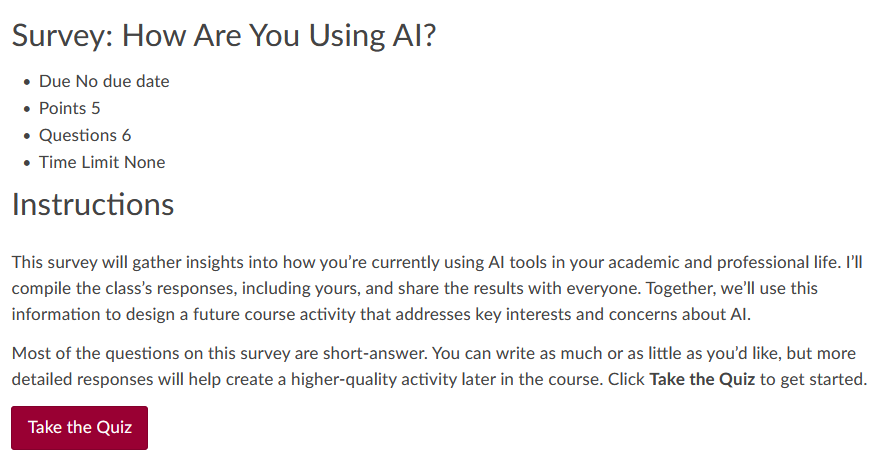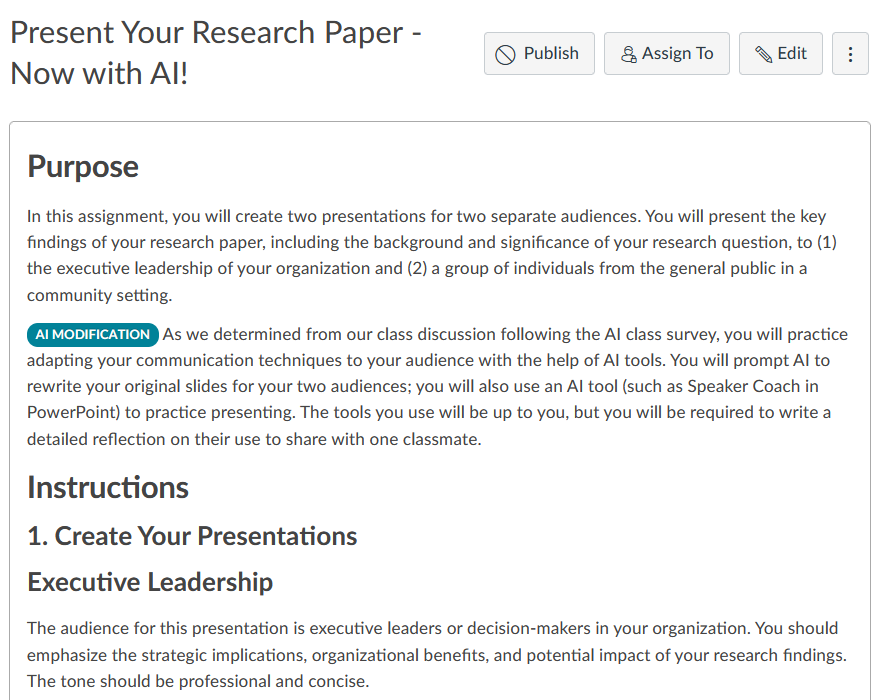Surveying Students About AI
Overview
Students are surveyed about how they are currently using AI in their professional and academic lives at the beginning of a course.
Why Use This?
This activity provides insight into how students are already using AI in their professional or academic work. It also reveals what students want or think they need to learn about AI. You can use this information as part of the course introduction or to enhance an existing assignment that allows them to develop these skills.
How Does It Work?
Students begin by completing a survey about their current use of AI. You can conduct this survey as part of the introductory discussion or collect the results to share with the class. After you’ve shared the results, you might decide to create an additional activity based on the findings. This activity can then be added to an existing assignment.
Here are some example questions to include in the survey:
- How do you currently use AI tools like ChatGPT?
- Do you use AI tools in the workplace? If so, for what purposes?
- Do you have any ethical questions or concerns about using AI?
- What would you like to learn about these tools?
- In Canvas, you can use the Quizzes option to build a survey (see the screenshot below).

Begin long description of previous image
Survey: How Are You Using AI?
Instructions
This survey will gather insights into how you’re currently using AI tools in your academic and professional life. I’ll compile the class’s responses, including yours, and share the results with everyone. Together, we’ll use this information to design a future course activity that addresses key interests and concerns about AI.
Most of the questions on this survey are short-answer. You can write as much or as little as you’d like, but more detailed responses will help create a higher-quality activity later in the course. Click Take the Quiz to get started.
End long description of previous image
After gathering your students’ responses, share them with the class. You might invite the class to brainstorm how to incorporate the findings into a course activity or develop an activity yourself. For example, if students express interest in exploring various AI tools for creating a presentation, you could design an activity where they use and reflect on different AI tools to carry out this task. Here’s an example:

Begin long description of previous image
Here is the text extracted from the image:
Present Your Research Paper – Now with AI!
Purpose
In this assignment, you will create two presentations for two separate audiences. You will present the key findings of your research paper, including the background and significance of your research question, to (1) the executive leadership of your organization and (2) a group of individuals from the general public in a community setting.
AI MODIFICATION
As we determined from our class discussion following the AI class survey, you will practice adapting your communication techniques to your audience with the help of AI tools. You will prompt AI to rewrite your original slides for your two audiences; you will also use an AI tool (such as Speaker Coach in PowerPoint) to practice presenting. The tools you use will be up to you, but you will be required to write a detailed reflection on their use to share with one classmate.
Instructions
1. Create Your Presentations
Executive Leadership
The audience for this presentation is executive leaders or decision-makers in your organization. You should emphasize the strategic implications, organizational benefits, and potential impact of your research findings. The tone should be professional and concise.
End long description of previous image
Keep In Mind
- Let students know they won’t be penalized for sharing if they’ve used AI tools for coursework. If your course has an AI policy, cite it to reassure students that there are appropriate ways to use AI, and clarify that past use won’t result in penalties.
- Summarize and share the survey results with students. Many will be curious to learn how their peers are using the technology—or if they’re not using it at all. The survey might also bring up interesting ethical questions for class discussion.
- Use the survey results to shape an assignment for a future course or to revise an existing AI policy.